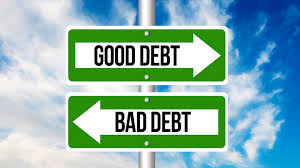
Good Debts vs Bad Debt: Know the difference and how to manage
Debt often carries a heavy stigma. Many people hear the word and immediately think of stress, sleepless nights, and financial hardship. But here is the truth, debt in and of itself is not bad. It is simply a tool — and like any tool, it can be used to build something valuable or, if misused, can cause damage.
The challenge lies not in whether you have debt, but in the type and amount you are carrying. Debt can be divided into two categories: good debt and bad debt. Understanding the difference is the first step toward making debt work for you rather than against you.
What is Good Debt?
Good debt is tied to an asset that either grows in value or improves your ability to earn more in the future. It is the kind of borrowing that positions you for long-term financial growth.
Think of good debt as an investment. While it may reduce your cash flow in the short term, it has the potential to strengthen your financial position over time.
Examples of Good Debt:
- Student Loans
Education can be expensive, but in many cases, it pays off. A degree or professional training can significantly boost your earning potential over your lifetime. For instance, someone who borrows $30,000 for a degree that leads to a higher-paying career could easily earn that back many times over.
- Mortgages
Buying a home is one of the most common forms of debt people take on. Unlike rent, mortgage payments go toward building equity in an asset that often appreciates in value over time. Real estate has historically grown in value, and property ownership can also bring tax advantages.
- Business Loans
Entrepreneurs often rely on loans to start or grow their businesses. If used wisely, this kind of debt can help generate profits, create jobs, and even build generational wealth. The risk is higher, but so is the potential reward.
What is Bad Debt?
Bad debt, on the other hand, does the opposite, it drains your finances without offering long-term benefits. It is often linked to purchases that depreciate quickly or to borrowing with high interest rates that increases over time.
Examples of Bad Debt:
- Credit Card Debt
Credit cards can be useful for convenience and rewards, but carrying a balance month to month without paying it off is dangerous. With interest rates often exceeding 20%, a small balance can balloon into a huge burden. Using credit to buy everyday items that you have not budget for, such as vacations, or luxuries that do not appreciate is a classic example of bad debt.
- Payday Loans
These are short-term loans with exorbitant interest rates that can trap borrowers in a cycle of repayment. They often do more harm than good, as borrowers roll over the debt again, digging a deeper hole each time. These types of loans are quite predatory and are targeted at persons with already poor credit or with limited financial knowledge.
- Car Loans for Depreciating Cars
While cars are often necessary, they lose value the moment you drive them off the lot. Borrowing large amounts for a luxury vehicle is an example of bad debt, especially if the payments take up a substantial chunk of your income.
How to manage debt wisely
The line between good and bad debt is not always clear. Even good debt can become a burden if you borrow more than you can repay. Likewise, sometimes what looks like bad debt might be unavoidable in the short term. The key is to borrow intentionally and manage responsibly.
Here are some practical strategies:
- Ask yourself, does this debt create value?
Before borrowing, consider whether the debt will increase your net worth or improve your income potential.
- Research the interest rates.
The higher the interest, the harder it becomes to manage. Even good debt can turn bad if interest payments outpace your returns.
- Borrow within your means.
Just because you can borrow a large sum does not mean you should. Keep your debt-to-income ratio manageable to avoid unnecessary stress.
- Prioritize repayment.
Focus on paying off high-interest debt first, while still making minimum payments on lower-interest loans. This strategy reduces the overall financial burden.
- Avoid emotional spending.
Many bad debt decisions come from impulse purchases or lifestyle inflation. Building financial discipline is just as important as managing numbers on a spreadsheet.
In Summary
Debt does not have to be a bad four-letter word. When used strategically, good debt can act as a steppingstone toward financial security and independence. It can help you buy a home, fund your education, or launch a business — all of which can increase wealth over time.
But debt can also be destructive. Bad debt creeps in quietly and grows quickly, often tied to things we want in the moment but do not need in the long run. Left unchecked, it erodes financial freedom and creates unnecessary stress. The difference comes down to this: Is your debt working for you, or are you working for your debt? If you can answer that honestly — and adjust your borrowing habits accordingly — you will have taken a big step toward mastering your financial future.
Check out this article on how debt can affect your health https://livingloudonabudget.com/how-lack-of-money-and-debt-affects-your-health/
The link between mental health and finances https://www.jamaicaobserver.com/2025/05/29/link-mental-health-finances/
Book a discovery call to discuss how we can help you get your finances in order https://calendly.com/tanja-livingloud/30min?month=2025-10